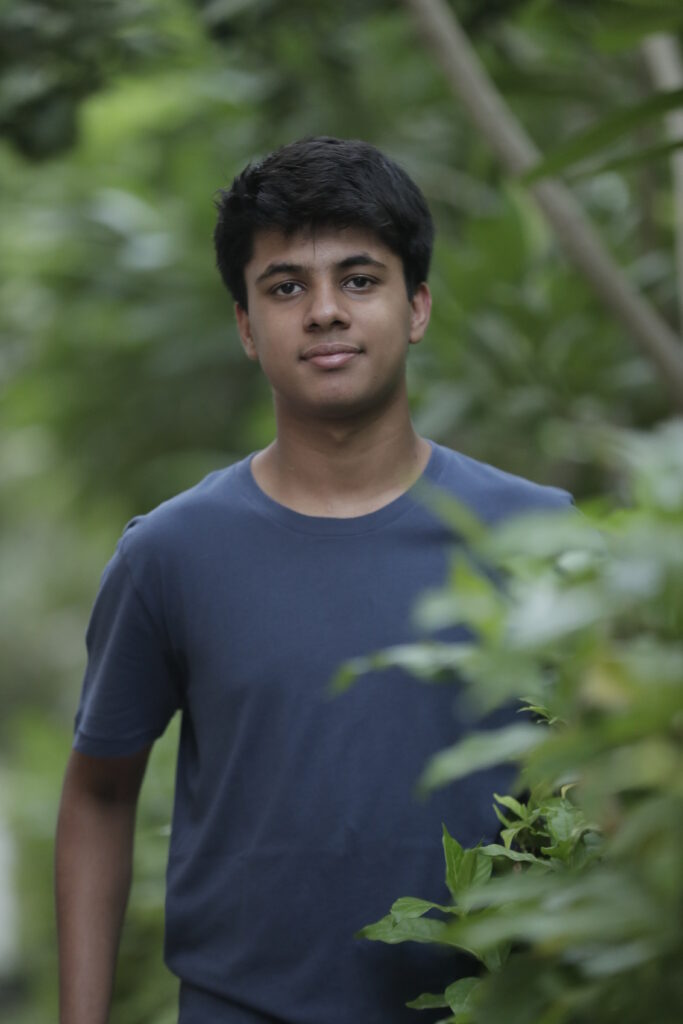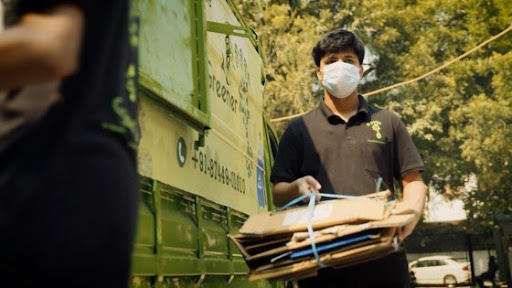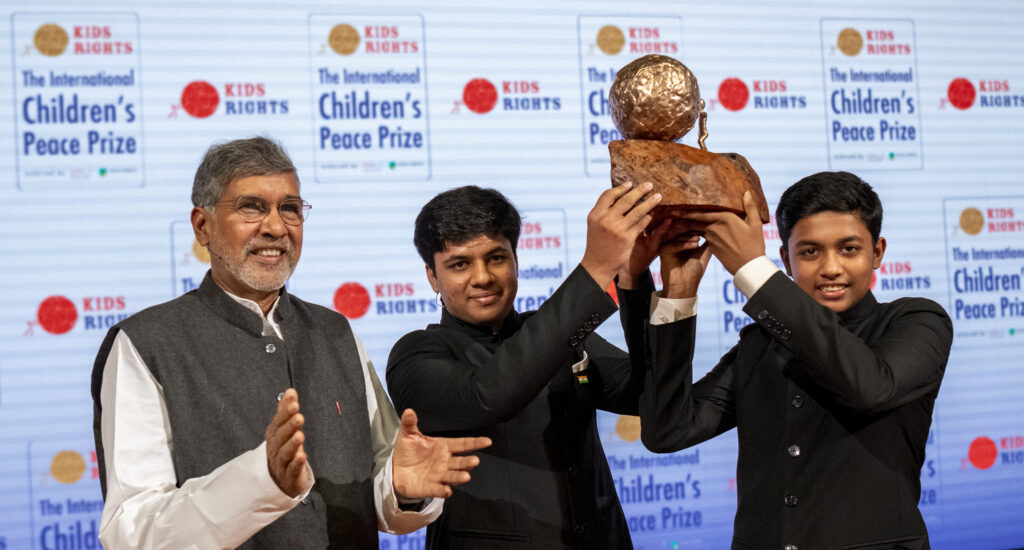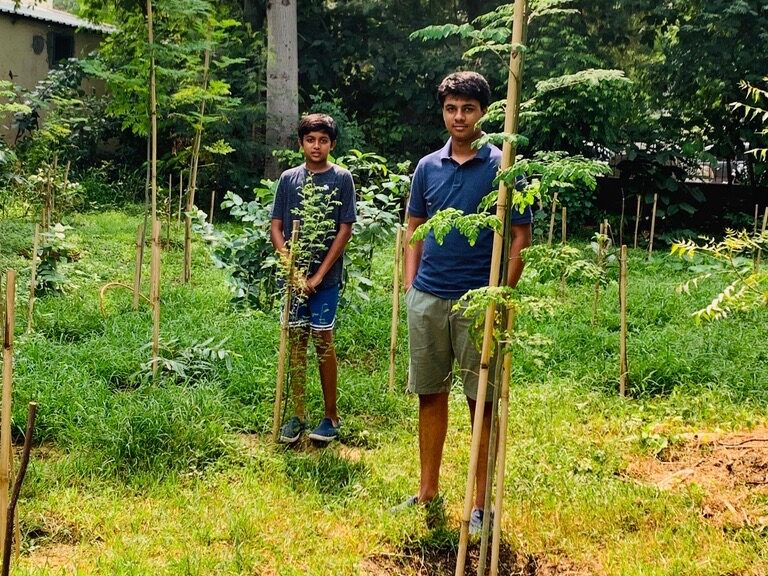Published: 04/19/2024
A conversation with Vihaan Agarwal (’26), who along with his brother is revolutionizing recycling in India to protect human health and the environment.
By Jamie Hansen, Global Health Communications Manager
Cover photo courtesy of Vihaan Agarwal, One Step Greener

Vihaan Agarwal (‘26) fell in love with nature from an early age. As a toddler growing up in New Delhi, India, he grasped for the flash cards with pictures of birds and later adopted his grandfather’s passion for nature photography. He and his younger brother always requested trips to parks and wildlife refuges, and he still remembers with awe sighting a leopard striding across a majestic old gate in Ranthambore National Park.
So when worsening air pollution driven by trash-burning in landfills threatened both his health and ability to enjoy the natural world, he took action. At age 14, he and his 11-year-old brother Nav began organizing their neighborhood to sort trash and deliver what couldn’t be composted to recycling companies — thereby diverting it from landfills.
That movement grew into One Step Greener, an environmental nonprofit and social initiative working toward a zero-waste future through waste management, recycling, education, and tree planting. They also prioritize providing dignified, safe jobs to workers in the informal waste collection sector. Today, they serve more than 25,000 households for whom they have recycled about 600,000 kilograms of waste, meanwhile planting more than 40,000 trees. In 2021, the brothers received the International Children’s Peace Prize for their work.
Now a sophomore at Stanford, Agarwal continues to expand One Step Greener’s impact while pursuing his education with a focus on sustainability and international relations. While juggling coursework with 3:00am Zoom calls to New Delhi isn’t always easy, he’s energized by the ideas and resources he’s gained from fellow students and faculty.
“A lot of the ideas I have for taking the organization forward wouldn’t be possible if I wasn’t here at Stanford,” he said.
He shared with us his story and insights for creating positive change that benefits people and the environment, one manageable step at a time.
How did you first become passionate about addressing pollution?
Around 7th grade, I started having a lot of asthma issues at the same time that air pollution in New Delhi started getting really bad. I was deeply passionate about wildlife and the environment and really wanted to do something to solve the problem that was hitting me hardest— air pollution. I planted some trees, but my research showed me this wouldn’t have a great impact and I wanted to take it a step further. At first I didn’t see anything more I could do about it.
Then, around 8th grade, pollution grew even worse, requiring children to attend school online or wear masks to protect themselves. Around that time, I was reading a newspaper on the way to school and saw an article about a fire in the city’s largest landfill, which was causing pollution throughout the city.
In that car ride, I made the connection that my waste was ending up in this landfill, which was causing air pollution, which affected me. I knew I needed to find a way to stop my waste from ending up in landfills.
In that car ride, I made the connection that my waste was ending up in this landfill, which was causing air pollution, which affected me. I knew I needed to find a way to stop my waste from ending up in landfills
Vihaan Agarwal, Stanford Undergraduate
Faced with such a daunting problem, how did you get started?
I started by doing some research and learned that the best way to keep the waste out of landfills was to segregate it so that it could be more easily recycled or composted. But this research was from countries with effective management systems for the waste, which was not the case in India. There were plenty of recycling companies in India, but they recycled imported waste from other countries. The supply chain just didn’t exist for them to get the waste from households like mine.
So I started composting my wet waste at home and storing my dry waste in the backyard. There was a point when our backyard became a mini mountain of dry waste, and my grandfather told me I had to do something about it.

But when I started calling recycling companies, they had no interest in handling my small amount of waste. We have WhatsApp groups for neighborhoods in India, so I messaged ours and invited our neighbors to get involved in this green initiative. That’s around the time we came up with the name One Step Greener, because we were trying to take one step towards a cleaner future. Within two weeks about 100 people signed up, which shocked us. We realized we needed to formalize the process, as my parents had been driving me around to pick up everyone’s recycling in their car and weren’t thrilled about it. We hired a truck and driver, and started storing the recycling in a vacant apartment basement that someone donated to us.
Were there ever moments of doubt or times you felt you were in over your head?
Oh, plenty of times. I remember walking into this basement filled with trash and thinking, “what in the world am I supposed to do with all this?”
I think I was definitely scared. But I was so passionate about this because I genuinely felt like every kilogram of waste I recycled was a personal victory. As one person, I’d been able to do something that benefited the environment.
I think I was definitely scared. But I was so passionate about this because I genuinely felt like every kilogram of waste I recycled was a personal victory. As one person, I’d been able to do something that benefited the environment.
Vihaan Agarwal, Stanford Undergraduate
At the time, we were very young and still in school, and we were growing alongside our organization in a sense. We took advice from our grandparents and parents, and my mom was very involved in the beginning since we were so young. But mostly there was just a lot of experimentation — going out, doing it, trying new things and figuring out how it would work. We very quickly realized we needed to set up systems by which things could work without us being involved on a day-to-day basis. We formalized our NGO and hired a supervisor and a team to segregate the waste. As the organization grew from 100 to 2,000 to now 25,000 homes we kept adding systems.

Now that you’re at Stanford, how does your education inform One Step Greener and vice versa? How are you balancing these huge demands?
It’s not always easy to balance. The time difference is most challenging. I finish my schoolwork by 9 or 10pm and I’m able to take a few meetings by the time it’s morning in India. But the main thing is that I don’t have to do a lot because so much is on autopilot. We have a proper management team and my brother back home is still there to help run things.
I am trying to add value by fundraising and using my time at Stanford to incorporate technology into the organization. We are committed to ensuring that we do our work in a green way. For instance, the vehicles that haul the waste are electric and I’m learning to map more efficient routes.
We recycle more than 95 percent of the waste that comes to us, and the rest (mostly single-use plastic) we store, which is expensive. Now, I’m trying to figure out manufacturing processes that will allow us to recycle single-use plastic. I’m talking to friends, classmates, and professors here to learn how to create the machines we need. We’re trying to close the loop completely.
What’s your advice to others looking to take that first step to address climate change or pollution?

Find an issue that’s affecting you or that you’re deeply passionate about. Think about it and think about what you can do – not necessarily to make massive change, but what’s the first step you can take?
Find an issue that’s affecting you or that you’re deeply passionate about. Think about it and think about what you can do – not necessarily to make massive change, but what’s the first step you can take?
Vihaan Agarwal, Stanford Undergraduate
Climate change is such a big existential threat that the natural response is fear — to question whether we can make a difference as one person. But fear shouldn’t lead to inaction. The premise of the speech that me and my brother gave when we won the Children’s Peace Prize was “take the plunge.” Yes, these problems seem so daunting. But unless you take the plunge, you’re not going to see how much you can do and the ripples you can make.
——-
Agarwal will be participating in the “Pollution and Health: Generating Evidence and Catalyzing Action to Advance Human and Planetary Health” conference on May 20-21. Learn more and register for the conference.
Anyone wishing to learn more or get involved can visit One Step Greener here.

